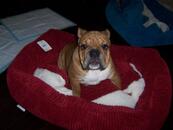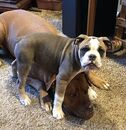Hello, my 3 year old had the tight rope procedure on his right knee 1.5 years ago and recovered well. He just tore his other ACL and requires surgery. I have read that TPLO is the “gold standard” for canine ACL repair but can’t find a lot of literature supporting one method over the other for the breed. Does anyone have experience with TPLO or any knowledge on which would be better for our dog? I want to make the best choice for him. Thank you!
You are using an out of date browser. It may not display this or other websites correctly.
You should upgrade or use an alternative browser.
You should upgrade or use an alternative browser.
TPLO or TightRope
- Thread starter Kayk1226
- Start date
-
- Tags
- acl ccl repair surgery
- Apr 18, 2014
- 7,055
- 1,058
- Country
- USA
- Bulldog(s) Names
- Cooper, Jewel (April 27, 2013-May 7, 2022-RIPDaddy's Girl) and (Bentley Oct 2013-Dec 2021)
First, Welcome to EBN.Hello, my 3 year old had the tight rope procedure on his right knee 1.5 years ago and recovered well. He just tore his other ACL and requires surgery. I have read that TPLO is the “gold standard” for canine ACL repair but can’t find a lot of literature supporting one method over the other for the breed. Does anyone have experience with TPLO or any knowledge on which would be better for our dog? I want to make the best choice for him. Thank you!

We have been through this 3 times with our small gang. Jewel has had both knees done and the right knee for Bentley. We live in Maryland and the cost has gone up about $100-$200 a year. Jewel's surgery in October 2016 was $3800. Both Jewel and Bentley are healthy and happy. Unfortunately, they have since passed away.
Here is a little bit about the TPLO procedure:
Tibial Plateau Leveling Osteotomy (TPLO)
Authored by: Dr. Greg Harasen
VP Client Information Sheets
|
If your dog has been diagnosed with a torn cranial cruciate ligament, you will probably be considering surgical treatment options that may include a tibial plateau leveling osteotomy (TPLO). The procedure is tough enough to say, let alone understand! The development of the TPLO is one of the most interesting stories in veterinary medicine.
A basic summary of this history will help in understanding why the TPLO has generated so much controversy. Descriptions of cranial cruciate ligament tears can be found for more than half a century in the veterinary literature. Indeed, cruciate disease is the most common orthopedic problem in dogs. In the early 1960s surgical techniques were developed to try and replace the damaged ligament or to eliminate the instability created in the stifle joint by tearing of it. Some techniques worked better than others, but all had their drawbacks and none completely stabilized the injured joint or prevented the development of significant arthritis.
Dr. Barclay Slocum, a surgeon who spent much of his career practicing in Eugene, Oregon, looked at the problem from a different perspective. Dr. Slocum’s father was a human orthopedic surgeon who frequently did corrective osteotomy procedures to treat knee ligament problems in people. In these procedures, the bones around the joint are cut and realigned to change abnormal forces within the knee. With these procedures in mind, Dr. Slocum examined the canine knee from the perspective of the dynamic forces that occur during weight-bearing and movement when the cranial cruciate ligament is torn. His examination of the dynamics combined with what was published in the veterinary literature in the early 1980s lead him to several conclusions. First, he noted that the top surface of the tibia (shin bone) that works together with the femur (thigh bone) at the knee joint had a tibial slope. Specifically, the top of the tibia slopes from front to back within the knee. The angle of this slope varies between dogs from degrees in the high teens to clearly abnormal slopes over 35 or 40 degrees. An average tibial plateau slope would be in the 21-24 degree range for most breeds. Slocum noted that the cruciate ligament ran between the femur and tibia and acted to hold the end of the femur in place atop the tibial plateau. He characterized the ligament as “a rope tying a wagon to the top of a hill.” When the rope (ligament) is broken, the wagon (the end of the femur) tends to slide down the hill (the tibial plateau slope). He characterized this instability, which had been named cranial tibial thrust, as the most important component of the dynamic instability that occurs in the stifle when the ligament tears. Further, he theorized that previous surgeries had been attempts to “replace the rope” and had met with only fair success. He wondered whether it might be more productive to “level the slope.” Slocum went about achieving this goal in a few different ways before he settled on what we now refer to as the TPLO.
Then he did a very interesting thing! Whereas the age-old procedure in medical research has been that when a new technique is developed it is published in a scientific publication and presented at scholarly meetings to allow one’s peers to scrutinize the information, but Slocum didn’t follow that path. Instead he patented the procedure and the equipment used to perform it. His scholarly writings and lectures were short on specific details and he spent a good portion of the later part of his career teaching the procedure out of his veterinary practice. Further, those he taught were required to sign contracts that they would not teach or publish details of the procedure to others. To call the reaction to this approach a firestorm within the veterinary community would not be an overstatement. The views of many concerning Slocum and the TPLO are colored by the controversy to this day.
Dr. Slocum passed away in 2000. His death had many important impacts on TPLO. First, the patents on the procedure, its teaching, and the related surgical equipment all expired. The result was that a great deal of independent research on the procedure began, in large part because many more surgeons were teaching and learning the procedure. The other natural progression, humans being the innovative creatures that we are, was that several variations of the technique and equipment to perform the surgery started to appear.
In recent years a number of other procedures have evolved. These include tibial tuberosity advancement (TTA), closing wedge osteotomy (CWO), and triple tibial osteotomy (TTO). All of these procedures can be thought of as different roads to the same destination. That is, they all alter the angles within the stifle joint to neutralize the cranial tibial thrust that Slocum concentrated on in the 1980s. All have their pluses and minuses and none has been shown to be superior to any of the others. In most cases the procedure that may be recommended for your dog will have as much to do with what your veterinary surgeon is most comfortable with as any other factor.
This article will deal only with the specifics of the TPLO.
|
|
Two views of a dog's stifle after TPLO surgery. Radiographs courtesy of Karen James.
How is the TPLO performed?
Before surgery, an x-ray of the stifle is taken to measure the angle at the top of the shin bone, called the tibial plateau angle. The goal of the surgery is to reduce this angle so that dynamic joint instability (cranial tibial thrust) is eliminated. This is usually accomplished by creating a post-surgical angle of between 4 and 10 degrees, an angle not much different than is found in the human knee. In most cases the surgical procedure starts with an exploration of the inside of the stifle joint. This can be done arthroscopically or with open joint surgery. The purpose is to assess the meniscal cartilages for any possible damage. Damaged cartilage must be removed if the dog is to regain normal pain-free function. The TPLO procedure itself involves the use of a curved saw blade to make a curved cut on the inside, or medial, surface of the top of the tibia. The cut top portion is then rotated to create the desired tibial plateau angle. A stainless steel bone plate is then placed on the bone to hold the two pieces in their new alignment.
Now that you know a bit about TPLO, let’s review some questions about the procedure.
Q: Does my dog really need surgery? I read that they’ll do just fine without surgery.
A: Published data suggest that approximately 15% of dogs will recover reasonably good clinical function without surgery. Most of those dogs will be small breeds, under 15-20 pounds of body weight. Those that recover normal function tend to do so within 4-6 weeks after they first become lame. For the majority of dogs, surgery is the only way to return them to good function, period…..not braces or medications or herbs or physical therapy or wishing or hoping!
Q: Which patients will benefit from TPLO?
A: While the procedure can be performed on just about any patient, including small dogs and cats, TPLO seems to be most applicable to larger breed, active dogs. Although some surgeons have differing opinions, most feel that smaller dogs will do equally well regardless of what procedure is performed. In general, dogs weighing over 45 pounds (20 kg), especially if they are very active, will benefit the most from TPLO.
Q: Why is TPLO so costly, especially when compared to other cruciate repair surgeries?
A: TPLO requires specialized equipment including a motorized bone saw with a specially-designed curved blade, a surgical stainless steel bone plate and 6-9 bone screws, between 4-6 x-rays, a significant investment in training on the part of the surgeon, and up to 2-4 hours of preparation, surgical and recovery time for each patient.
Q: What aftercare is required?
A: Individual surgeons approach this differently and there is no hard evidence to suggest what is best. Some restrict post-operative patients from climbing stairs and encourage kenneling when the owners are not home to supervise their pet. Others encourage leash walks and moderate exercise under the owner’s control. Still others advocate active physical rehabilitation beginning immediately after surgery. All will require follow-up x-rays at various stages to gauge healing of the cut in the bone. Once bone healing is complete, then exercise can be gradually increased to normal.
Q: What about possible complications?
A: TPLO is a major surgery and complications are possible. Published reports suggest the complication rates may be somewhat higher than with less invasive surgeries, but other factors may be involved including patient factors and surgeon experience with the procedure. Most complications are minor in nature in that they can be resolved without additional surgery and have an ultimately successful outcome. Included in this category would be things like infections and inflammation of the patellar tendon. More major complications, including failure of plates or screws and fracture of the tibia or fibula, are uncommon. The development of bone cancer many months or years later in the area of the surgery has been noted in a small number of TPLO dogs. The possible connection of this cancer with the procedure is highly controversial as the top portion of the tibia is a common location for bone cancer in the dog even when no surgery or cruciate problem is a factor. Whether the rate of such cancers in TPLO dogs is higher than normal is not clear. One of the most common post-operative complications is not directly related to the TPLO procedure. Tears of the meniscal cartilage in the stifle are a common consequence of an unstable joint. Such tears may exist at the time of surgery and they can develop in up to 11% of patients after surgery. That’s true in dogs and humans regardless of what kind of surgery they undergo. Typically, these patients do well for weeks or months after surgery before suddenly becoming lame again.
Q: Is TPLO really better than other surgical options?
A: If your dog is larger, younger and active the answer is yes. The data has not always been conclusive about this, however. For a good part of the first 20-25 years after the development of TPLO, surgeons were faced with a paradox: they were seeing significantly better results with TPLO than with other procedures they had used in large dogs….but the research data wasn’t backing up these observations. Why? Undoubtedly, Dr. Barclay Slocum’s decision to restrict availability of the procedure through patenting of the technique and equipment had a major effect on the amount of research that was done.
In addition, one must realize that veterinary research is always more restricted in scope and numbers than is seen in human medicine. The New England Journal of Medicine will commonly publish studies involving tens or hundreds of thousands of human test subjects. In veterinary medicine a study of 50 animals is a big study! Why? Money. The difference in available research funds between human and veterinary medicine is astronomical, which probably isn’t surprising. In the last few years, the research data is starting to confirm what surgeons have known all along: TPLO dogs return to function faster, they develop less joint arthritis, and they tend to return to better functional levels than is seen with other techniques. Although we can’t say for certain, it appears that these positive results also apply to other similar techniques such as TTA, CWO, and TTO.
I hope this helps. RJ
Bulldog2001
Well-known member
- May 5, 2022
- 1,134
- 851
- Country
- Canada
- Bulldog(s) Names
- None yet
Hello, my 3 year old had the tight rope procedure on his right knee 1.5 years ago and recovered well. He just tore his other ACL and requires surgery. I have read that TPLO is the “gold standard” for canine ACL repair but can’t find a lot of literature supporting one method over the other for the breed. Does anyone have experience with TPLO or any knowledge on which would be better for our dog? I want to make the best choice for him. Thank you!
Welcome!
I haven’t had a dog with this before.
But I highly recommend keeping his weight on the slim side cause overweight dogs tend to have more joint issues.
What do you feed??
Improve the diet is also gonna help the joints and ligaments too, high quality low carb food is best to keep inflammation down too.
In the meantime limit exercise so he doesn’t get worse or be in more pain.
Adding joint Supplement would be beneficial to him.
I give Green lipped mussel powder to my dogs which is great for joints.
However, one of my dogs flared up with inflamed joints/spine from IVDD from a fall during playing(that caused the flare up and was completely out of my control to be prevented).
He is healing but still sore, every time we we’re told to slowly increase play, he would get a little more sore.
I started him on Four Leaf Rover brand Hip Joint supplement cause it has eggshell membrane(very good for joints), and Green lipped mussel also and Curcumin which is the active ingredient in tumeric with the benefits and makes it anti inflammatory. I started him on it exactly 9 days ago, and 4 days ago OMG did I ever see a difference in him wanting to play, we all were happy he was starting to feel much better and actually want to play like he used to.
We were told he is less inflamed and improving and to keep doing what we are doing for him.
He also gets Laser Therapy as well which helps too.
I highly recommend that supplement for joints as maintenance and preventative too.
Some use coconut oil but that can cause inflammation and cause leaky gut and cancer. So I recommend avoiding coconut oil.
During sudden joint pain, I also give Adored Beast Jump For JOYnts extra strength spray which is good for these kinds of things too it says.
My neighbour has a big Dog ,she IS a vet, dog is over 15-20lb overweight and low quality food being fed to her.
She had 2 surgeries(1 on each back leg), and since then, she seems anxious to walk on the floor without mats.
She doesn’t seem to walk as good as before the surgery, seems to have less balance.
Keep us updated
Last edited:
- Thread Starter
- Thread starter
- #4
First, Welcome to EBN.
We have been through this 3 times with our small gang. Jewel has had both knees done and the right knee for Bentley. We live in Maryland and the cost has gone up about $100-$200 a year. Jewel's surgery in October 2016 was $3800. Both Jewel and Bentley are healthy and happy. Unfortunately, they have since passed away.
Here is a little bit about the TPLO procedure:
Tibial Plateau Leveling Osteotomy (TPLO)
Authored by: Dr. Greg Harasen
VP Client Information Sheets
Click here to view the original image of 500x288px.
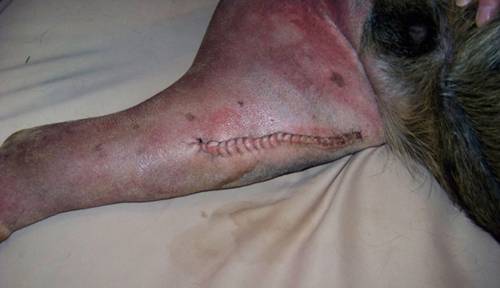
This incision is from a TPLO. Photo courtesy of Nanette Walker.
If your dog has been diagnosed with a torn cranial cruciate ligament, you will probably be considering surgical treatment options that may include a tibial plateau leveling osteotomy (TPLO). The procedure is tough enough to say, let alone understand! The development of the TPLO is one of the most interesting stories in veterinary medicine.
A basic summary of this history will help in understanding why the TPLO has generated so much controversy. Descriptions of cranial cruciate ligament tears can be found for more than half a century in the veterinary literature. Indeed, cruciate disease is the most common orthopedic problem in dogs. In the early 1960s surgical techniques were developed to try and replace the damaged ligament or to eliminate the instability created in the stifle joint by tearing of it. Some techniques worked better than others, but all had their drawbacks and none completely stabilized the injured joint or prevented the development of significant arthritis.
Dr. Barclay Slocum, a surgeon who spent much of his career practicing in Eugene, Oregon, looked at the problem from a different perspective. Dr. Slocum’s father was a human orthopedic surgeon who frequently did corrective osteotomy procedures to treat knee ligament problems in people. In these procedures, the bones around the joint are cut and realigned to change abnormal forces within the knee. With these procedures in mind, Dr. Slocum examined the canine knee from the perspective of the dynamic forces that occur during weight-bearing and movement when the cranial cruciate ligament is torn. His examination of the dynamics combined with what was published in the veterinary literature in the early 1980s lead him to several conclusions. First, he noted that the top surface of the tibia (shin bone) that works together with the femur (thigh bone) at the knee joint had a tibial slope. Specifically, the top of the tibia slopes from front to back within the knee. The angle of this slope varies between dogs from degrees in the high teens to clearly abnormal slopes over 35 or 40 degrees. An average tibial plateau slope would be in the 21-24 degree range for most breeds. Slocum noted that the cruciate ligament ran between the femur and tibia and acted to hold the end of the femur in place atop the tibial plateau. He characterized the ligament as “a rope tying a wagon to the top of a hill.” When the rope (ligament) is broken, the wagon (the end of the femur) tends to slide down the hill (the tibial plateau slope). He characterized this instability, which had been named cranial tibial thrust, as the most important component of the dynamic instability that occurs in the stifle when the ligament tears. Further, he theorized that previous surgeries had been attempts to “replace the rope” and had met with only fair success. He wondered whether it might be more productive to “level the slope.” Slocum went about achieving this goal in a few different ways before he settled on what we now refer to as the TPLO.
Then he did a very interesting thing! Whereas the age-old procedure in medical research has been that when a new technique is developed it is published in a scientific publication and presented at scholarly meetings to allow one’s peers to scrutinize the information, but Slocum didn’t follow that path. Instead he patented the procedure and the equipment used to perform it. His scholarly writings and lectures were short on specific details and he spent a good portion of the later part of his career teaching the procedure out of his veterinary practice. Further, those he taught were required to sign contracts that they would not teach or publish details of the procedure to others. To call the reaction to this approach a firestorm within the veterinary community would not be an overstatement. The views of many concerning Slocum and the TPLO are colored by the controversy to this day.
Dr. Slocum passed away in 2000. His death had many important impacts on TPLO. First, the patents on the procedure, its teaching, and the related surgical equipment all expired. The result was that a great deal of independent research on the procedure began, in large part because many more surgeons were teaching and learning the procedure. The other natural progression, humans being the innovative creatures that we are, was that several variations of the technique and equipment to perform the surgery started to appear.
In recent years a number of other procedures have evolved. These include tibial tuberosity advancement (TTA), closing wedge osteotomy (CWO), and triple tibial osteotomy (TTO). All of these procedures can be thought of as different roads to the same destination. That is, they all alter the angles within the stifle joint to neutralize the cranial tibial thrust that Slocum concentrated on in the 1980s. All have their pluses and minuses and none has been shown to be superior to any of the others. In most cases the procedure that may be recommended for your dog will have as much to do with what your veterinary surgeon is most comfortable with as any other factor.
This article will deal only with the specifics of the TPLO.
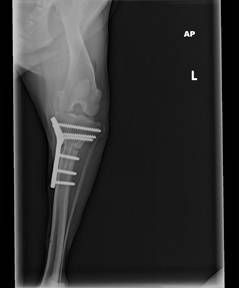
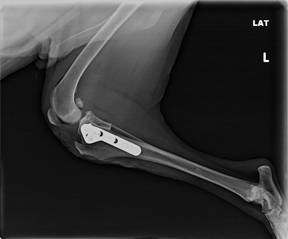
Two views of a dog's stifle after TPLO surgery. Radiographs courtesy of Karen James.
How is the TPLO performed?
Before surgery, an x-ray of the stifle is taken to measure the angle at the top of the shin bone, called the tibial plateau angle. The goal of the surgery is to reduce this angle so that dynamic joint instability (cranial tibial thrust) is eliminated. This is usually accomplished by creating a post-surgical angle of between 4 and 10 degrees, an angle not much different than is found in the human knee. In most cases the surgical procedure starts with an exploration of the inside of the stifle joint. This can be done arthroscopically or with open joint surgery. The purpose is to assess the meniscal cartilages for any possible damage. Damaged cartilage must be removed if the dog is to regain normal pain-free function. The TPLO procedure itself involves the use of a curved saw blade to make a curved cut on the inside, or medial, surface of the top of the tibia. The cut top portion is then rotated to create the desired tibial plateau angle. A stainless steel bone plate is then placed on the bone to hold the two pieces in their new alignment.
Now that you know a bit about TPLO, let’s review some questions about the procedure.
Q: Does my dog really need surgery? I read that they’ll do just fine without surgery.
A: Published data suggest that approximately 15% of dogs will recover reasonably good clinical function without surgery. Most of those dogs will be small breeds, under 15-20 pounds of body weight. Those that recover normal function tend to do so within 4-6 weeks after they first become lame. For the majority of dogs, surgery is the only way to return them to good function, period…..not braces or medications or herbs or physical therapy or wishing or hoping!
Q: Which patients will benefit from TPLO?
A: While the procedure can be performed on just about any patient, including small dogs and cats, TPLO seems to be most applicable to larger breed, active dogs. Although some surgeons have differing opinions, most feel that smaller dogs will do equally well regardless of what procedure is performed. In general, dogs weighing over 45 pounds (20 kg), especially if they are very active, will benefit the most from TPLO.
Q: Why is TPLO so costly, especially when compared to other cruciate repair surgeries?
A: TPLO requires specialized equipment including a motorized bone saw with a specially-designed curved blade, a surgical stainless steel bone plate and 6-9 bone screws, between 4-6 x-rays, a significant investment in training on the part of the surgeon, and up to 2-4 hours of preparation, surgical and recovery time for each patient.
Q: What aftercare is required?
A: Individual surgeons approach this differently and there is no hard evidence to suggest what is best. Some restrict post-operative patients from climbing stairs and encourage kenneling when the owners are not home to supervise their pet. Others encourage leash walks and moderate exercise under the owner’s control. Still others advocate active physical rehabilitation beginning immediately after surgery. All will require follow-up x-rays at various stages to gauge healing of the cut in the bone. Once bone healing is complete, then exercise can be gradually increased to normal.
Q: What about possible complications?
A: TPLO is a major surgery and complications are possible. Published reports suggest the complication rates may be somewhat higher than with less invasive surgeries, but other factors may be involved including patient factors and surgeon experience with the procedure. Most complications are minor in nature in that they can be resolved without additional surgery and have an ultimately successful outcome. Included in this category would be things like infections and inflammation of the patellar tendon. More major complications, including failure of plates or screws and fracture of the tibia or fibula, are uncommon. The development of bone cancer many months or years later in the area of the surgery has been noted in a small number of TPLO dogs. The possible connection of this cancer with the procedure is highly controversial as the top portion of the tibia is a common location for bone cancer in the dog even when no surgery or cruciate problem is a factor. Whether the rate of such cancers in TPLO dogs is higher than normal is not clear. One of the most common post-operative complications is not directly related to the TPLO procedure. Tears of the meniscal cartilage in the stifle are a common consequence of an unstable joint. Such tears may exist at the time of surgery and they can develop in up to 11% of patients after surgery. That’s true in dogs and humans regardless of what kind of surgery they undergo. Typically, these patients do well for weeks or months after surgery before suddenly becoming lame again.
Q: Is TPLO really better than other surgical options?
A: If your dog is larger, younger and active the answer is yes. The data has not always been conclusive about this, however. For a good part of the first 20-25 years after the development of TPLO, surgeons were faced with a paradox: they were seeing significantly better results with TPLO than with other procedures they had used in large dogs….but the research data wasn’t backing up these observations. Why? Undoubtedly, Dr. Barclay Slocum’s decision to restrict availability of the procedure through patenting of the technique and equipment had a major effect on the amount of research that was done.
In addition, one must realize that veterinary research is always more restricted in scope and numbers than is seen in human medicine. The New England Journal of Medicine will commonly publish studies involving tens or hundreds of thousands of human test subjects. In veterinary medicine a study of 50 animals is a big study! Why? Money. The difference in available research funds between human and veterinary medicine is astronomical, which probably isn’t surprising. In the last few years, the research data is starting to confirm what surgeons have known all along: TPLO dogs return to function faster, they develop less joint arthritis, and they tend to return to better functional levels than is seen with other techniques. Although we can’t say for certain, it appears that these positive results also apply to other similar techniques such as TTA, CWO, and TTO.
I hope this helps. RJ
Thank you so much for this RJ, I appreciate it!
- Thread Starter
- Thread starter
- #5
Thank you for this information! His weight is ok, we are continually working on it as he is a pretty lazy guy. I will look into the supplements you listed, thank you!Welcome!
I haven’t had a dog with this before.
But I highly recommend keeping his weight on the slim side cause overweight dogs tend to have more joint issues.
What do you feed??
Improve the diet is also gonna help the joints and ligaments too, high quality low carb food is best to keep inflammation down too.
In the meantime limit exercise so he doesn’t get worse or be in more pain.
Adding joint Supplement would be beneficial to him.
I give Green lipped mussel powder to my dogs which is great for joints.
However, one of my dogs flared up with inflamed joints/spine from IVDD from a fall during playing(that caused the flare up and was completely out of my control to be prevented).
He is healing but still sore, every time we we’re told to slowly increase play, he would get a little more sore.
I started him on Four Leaf Rover brand Hip Joint supplement cause it has eggshell membrane(very good for joints), and Green lipped mussel also and Curcumin which is the active ingredient in tumeric with the benefits and makes it anti inflammatory. I started him on it exactly 9 days ago, and 4 days ago OMG did I ever see a difference in him wanting to play, we all were happy he was starting to feel much better and actually want to play like he used to.
We were told he is less inflamed and improving and to keep doing what we are doing for him.
He also gets Laser Therapy as well which helps too.
I highly recommend that supplement for joints as maintenance and preventative too.
Some use coconut oil but that can cause inflammation and cause leaky gut and cancer. So I recommend avoiding coconut oil.
During sudden joint pain, I also give Adored Beast Jump For JOYnts extra strength spray which is good for these kinds of things too it says.
My neighbour has a big Dog ,she IS a vet, dog is over 15-20lb overweight and low quality food being fed to her.
She had 2 surgeries(1 on each back leg), and since then, she seems anxious to walk on the floor without mats.
She doesn’t seem to walk as good as before the surgery, seems to have less balance.
Keep us updated
- Apr 18, 2014
- 7,055
- 1,058
- Country
- USA
- Bulldog(s) Names
- Cooper, Jewel (April 27, 2013-May 7, 2022-RIPDaddy's Girl) and (Bentley Oct 2013-Dec 2021)
Keep us posted. Positive vibes and prayers to you and your family.Thank you so much for this RJ, I appreciate it!
- Jul 28, 2011
- 48,593
- 3,688
- Country
- USA
- Bulldog(s) Names
- Chelios (Frenchie), Cubby (Frenchie) Nitschke (2004-2011) Banks (2005-2014) and Lambeau (2014-2024)
Welcome to EBN.... can't add anything to what Roger has provided - nothing better than real life experience information!
Best of luck and please keep us posted on your baby!
Best of luck and please keep us posted on your baby!
Last edited:
- Apr 18, 2014
- 7,055
- 1,058
- Country
- USA
- Bulldog(s) Names
- Cooper, Jewel (April 27, 2013-May 7, 2022-RIPDaddy's Girl) and (Bentley Oct 2013-Dec 2021)
juncotton27
New member
Hello, my 3 year old had the tight rope procedure on his right knee 1.5 years ago and recovered well. He just tore his other ACL and requires surgery. I have read that TPLO is the “gold standard” for canine ACL repair but can’t find a lot of literature supporting one method over the other for the breed. Does anyone have experience with TPLO or any knowledge on which would be better for our dog? I want to make the best choice for him. Thank you!
hi, my mom's dog had her TPLO surgery a few years back. She got it from playing a lot and jumping everywhere. When I saw her limping, I phoned my vet and was scheduled for a check-up. And she was advised that she needs to undergo surgery since she tore her ACL. The surgery was quick, and the recovery took months but it was worth it since she's back in good shape and was able to play a lot again.
Similar threads
- Replies
- 14
- Views
- 5K
- Replies
- 21
- Views
- 9K
AVAILABLE FOR ADOPTION!
~Gus~English Bulldog Available for Adoption in Texas
- Replies
- 0
- Views
- 2K

